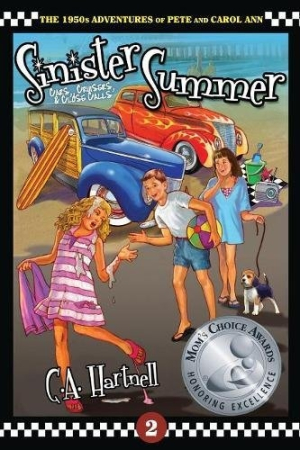Sinister Summer
Cars, Cruisers, and Close Calls
Childhood adventures capture the culture of the 1950s in Sinister Summer.
Lighthearted summer fun mixes with worry and fear in C. A. Hartnell’s Sinister Summer, a chapter book about faith, family, and friends.
In the 1950s, Carol Ann is a carefree eleven-year-old who spends much of her time with her siblings and her neighbor and best friend, Pete. Their biggest concerns are the angry older boys who drive souped-up cars through their neighborhood, The Cruisers. The Cruisers always seem to be looking for trouble.
As Carol Ann and Pete seek adventures throughout their summer, they encounter instances of racial prejudice, reckless behavior, and accidental peril, as when her car door swings open while they’re on a car trip. Two or three subplots contain mysterious elements that perplex the friends, but that are resolved by the end of the book.
Through it all, Carol Ann turns to the Bible for comfort and reassurance, sharing any verses that she finds to be helpful with Pete, who appreciates them as well. Conversations between Carol Ann and Pete are overly proper for children of their ages, though.
The conflict with the Cruisers is overwrought, given how little Carol Ann and Pete interact with the older kids. Even when an entire chapter deals with a happy day spent out of town on a trip, Carol Ann’s thoughts drift to the danger of the Cruisers, despite them not being present. Conflicts like being pulled underwater by a wave at the beach are more authentic expressions of childhood fear.
A wide cast of characters, including Pete and Carol Ann’s families, allows for a variety of smaller adventures that highlight the unstructured time that the children spend together. Keeping track of the characters is easier because of an included chart of names and ages.
Characters like Pete’s sister Mary Jane grow over the course of the book, and the presence of older teens, like Pete’s brother Hawk, allows for dialogue that doubles as plot development and that introduces educational information about the cars, habits, and customs of the 1950s.
Carol Ann’s story draws much of its strength from this portrayal of 1950s culture. Descriptions of beaches, neighborhood parades, and cruising are entertaining, and scenes such as one at a Fourth of July parade are evocative and nostalgic. Extra resources, including a glossary of 1950s terms and a list of what things cost then, further the history lesson element of the book.
Two friends’ childhood adventures capture the culture of the 1950s in the faith-based Sinister Summer.
Reviewed by
Laura Leavitt
Disclosure: This article is not an endorsement, but a review. The publisher of this book provided free copies of the book and paid a small fee to have their book reviewed by a professional reviewer. Foreword Reviews and Clarion Reviews make no guarantee that the publisher will receive a positive review. Foreword Magazine, Inc. is disclosing this in accordance with the Federal Trade Commission’s 16 CFR, Part 255.

